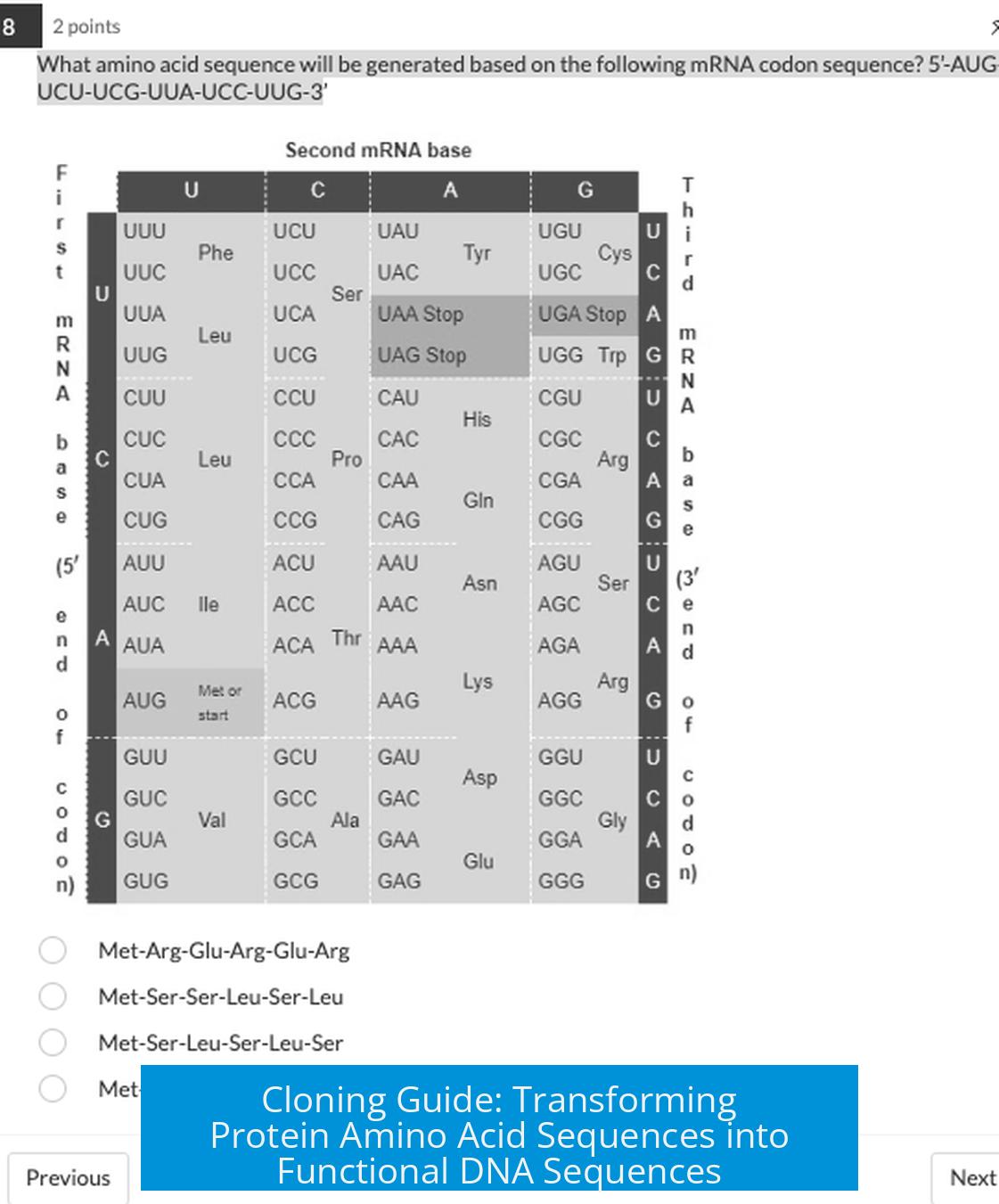Cloning Guide from Protein Amino Acid Sequence

Cloning a gene starting from a protein amino acid sequence involves converting the protein sequence into a corresponding DNA coding sequence (CDS), optimizing it for the expression host if necessary, inserting it into a suitable vector at the multiple cloning site (MCS), and ensuring all regulatory elements support efficient transcription and translation.
Step 1: Converting Protein Sequence to DNA Coding Sequence (CDS)
The cloning process begins with identifying the full-length CDS corresponding to the protein sequence. Proteins start translation at the methionine (Met) residue and end at the stop codon.
- Use open reading frame (ORF) prediction tools available from sources like the European Bioinformatics Institute (EBI) to back-translate the amino acid sequence into a nucleotide sequence.
- Begin the sequence with the start codon (ATG for Met) and end with an appropriate stop codon (TAA, TAG, or TGA).
- UniProt and GenBank are reliable databases offering complete, verified protein sequences for accurate back-translation.
This step ensures the DNA sequence fully encodes the intended protein without missing regions or premature stops.
Step 2: Codon Optimization for Expression Host
Once the CDS is established, codon optimization may be necessary to enhance gene expression efficiency in the chosen host organism.
- Bacterial genes expressed in eukaryotic hosts, or vice versa, often require codon optimization to match the host’s tRNA availability.
- Mammalian genes cloned back into mammalian expression systems usually do not require this step unless gene synthesis is needed to resolve PCR challenges such as high GC content.
- Codon optimization can improve translation speed and yield but should preserve the original amino acid sequence.
Step 3: Selection of Expression Vector and Cloning Sites
The next step is selecting an expression vector that includes a multiple cloning site (MCS) compatible with your cloning strategy.
- The MCS should be cleaved with restriction enzymes matching your cloning method, whether conventional restriction-ligation or Gibson assembly.
- The gene insert should be ligated or assembled precisely into this site to ensure proper vector function.
- As a general approach, the gene is cloned as a single open reading frame without internal ribosome entry sites (IRES) unless polycistronic expression is intended.
This precise insertion ensures that the gene integrates into the vector backbone, maintaining the correct reading frame and regulatory context.
Step 4: Regulatory Elements for Efficient Gene Expression
Most commercial vectors provide essential regulatory sequences required for gene expression. These include promoters, ribosome binding sites, and terminators.
- Prokaryotic systems utilize promoters that initiate transcription (e.g., T7 or lac promoters), followed by ribosome binding sites (RBS) that start translation.
- Eukaryotic expression vectors contain promoters like CMV, polyadenylation signals, and importantly, a Kozak sequence surrounding the start codon to facilitate translation initiation.
- The Translation Initiation Region (TIR) combines sequence elements enabling ribosomes to initiate translation efficiently.
Confirming these regulatory features in your vector is vital to achieve high levels of protein expression.
Step 5: Sequence Verification and Isoform Selection
Accurate sequence data is crucial for effective cloning. For species like human and mouse, use curated databases such as GenBank’s Consensus CDS (CCDS) rather than UniProt alone.
- CCDS consolidates multiple annotation sources, minimizing missing alternative splicing isoforms or sequencing errors.
- Check for alternative splicing variants or isoforms relevant to your experimental goals to avoid cloning incomplete or non-representative sequences.
- Verify the entire sequence from start codon to stop codon matches the protein sequence intended for expression.
Step 6: Tailoring Cloning Approach Based on Expression Host
The choice of host cell influences cloning and expression strategies significantly.
- Prokaryotes: Bacterial hosts like Escherichia coli require codon usage compatible with bacterial tRNA pools. Expression vectors must have bacterial promoters and an RBS before the start codon.
- Eukaryotes: Mammalian or insect cell expression requires vectors with eukaryotic promoters (e.g., CMV), a Kozak consensus sequence, and polyadenylation signals.
- Expression host also dictates downstream applications: protein purification may use affinity tags, while functional studies may need fusion constructs preserving activity.
Step 7: Practical Cloning Strategies
Depending on the available tools and project specifics, choose the cloning method that fits your needs.
- Restriction enzyme cloning: Digest both vector and insert with compatible enzymes, then ligate.
- Gibson Assembly: Design overlapping sequences for seamless insertion without restriction sites.
- Site-directed mutagenesis or synthetic genes: Useful if PCR amplification is problematic due to sequence complexity.
Each technique requires planning to ensure correct frame insertion and minimal noncoding sequence inclusion.
Summary Table of Key Considerations
| Step | Key Point | Details |
|---|---|---|
| 1. Back-translation | From Met to Stop codon | Use ORF tools; UniProt/GenBank sequences |
| 2. Codon Optimization | Depends on host | Optimize for host tRNA, especially cross-species |
| 3. Cloning Vector | Select compatible MCS | Use restriction sites matching cloning strategy |
| 4. Regulatory Sequences | Promoter, RBS, Kozak sequence | Ensure vector contains functional elements |
| 5. Sequence Validation | Use CCDS for accuracy | Account for isoforms and splice variants |
| 6. Host Choice | Influences codon use and vector design | Bacterial vs. eukaryotic expression systems |
| 7. Cloning Method | Restriction-ligation, Gibson assembly, etc. | Choose based on tools and sequence complexity |
Key Takeaways
- Start cloning with a DNA sequence from the protein’s Met to stop codon region.
- Perform codon optimization when expressing genes in heterologous hosts.
- Insert gene into an expression vector’s multiple cloning site using appropriate enzymes or assembly methods.
- Confirm that vectors have correct promoters and regulatory sequences, including Kozak sequences in eukaryotes.
- Use curated databases like GenBank’s CCDS for precise sequence information and alternative isoforms.
- Tailor cloning strategies based on the expression host and the intended application.





Leave a Comment